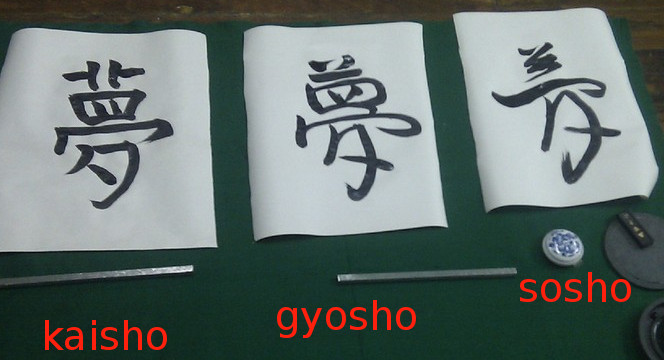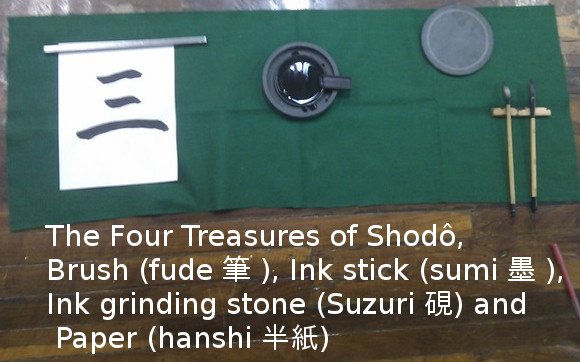SHODO 書道 Japanese Calligraphy - The Path of The Brush
SHODÔ - 書道
Is the art of japanese calligraphy. Is considered a cultural tradition of Japan, even though children in Japan learn shodô at school, there are many people that keep practicing and cultivating this art for most of their lifetime. A lot of japanese artists have practiced shodô throughout history and their works are exhibited at museums like real master pieces.
Shodô styles can be classified in five groups:
• Kaisho - 楷書, block letters, print type
• Sôsho - 草書, cursive
• Gyôsho - 行書, semicursive
• Tensho - 篆書, seals letters
• Reisho - 隷書, clerical

As with other cultural arts, learning Shodo starts with imitating the Master's Art. Children at school imitate the Shodo textbook, children who take Shodo lessons imitate their teacher's work. Advanced Artists imitate the works of Great Shodo Artists from centuries ago.
Imitating the great works of the past is called Rinsho– 臨書, and is one form of artistic expression in Shodo. This may sound strange to you, but think about classical music; people today play the works of Beethoven and Mozart, which is considered a form of artistic expression rather than "copying" someone's art.
With enough experience of Rinsho of different works and different Artists, you are ready to add your creativity to Shodo. Some artists create Art inspired by the great works from the past, while others create unique styles.
Richness of written japanese language, expressed by its three alphabets: Kanji, Hiragana and Katakana, expands the possibilities of expression through Shodô.
There are many koryû schools of this ancient tradition that have survived nowdays, its students, instructors, masters and everyone who practices it, give life to Shodô art.
Shodô practice requires some basic instruments, called The Four Treasures of Shodô, those are Brush (fude 筆), Ink stick (sumi 墨), Ink grinding stone (Suzuri 硯) and Paper (hanshi 半紙). Brush is made from natural animal hair and bamboo, Ink stick is made of tree bark charcoal and vegetable resins, Ink stone is a craved rock, paper is made from natural fibers like rice and tree bark. All of them are of natural origin, being evident the nobleness of this art inspired by nature and respectful towards the environment.

The Four Treasures of Shodô, Brush (fude 筆), Ink stick (sumi 墨), Ink grinding stone
(Suzuri 硯) and Paper (hanshi 半紙)
At Venezuela, shodô art has been developed mostly thanks to the efforts of Jon Mansen (満湶) Leniz. He was ordained as a Zen priest in 1997 by Yves Zengaku Nansen (禅岳南仙) Carouget Sensei, disciple of Taisen Deshimaru (弟子丸泰仙) Rōshi (老師). In 1998 he began studying shodō and sumi-e in the Venezuelan school of calligraphy and Zen painting "Water Buddhas”, founded by Paul Dōsho (道 照) Quintero Sensei, receiving his teacher’s license in 2004. In 2010 participate in an workshop with Kazuaki Tanahashi Sensei at The United States. Next year receives teachings from Seikou Kaneko Sensei, 8th Dan master of Nihon-Syuji school.He has taught at various Zen centers in Venezuela, been invited to demonstrate shodō at the Japanese Cultural Festival of Caracas and other cities by the Japanese Embassy in Venezuela, and currently teaches shodō and sumi-e at the Nikkei and Japanese Federation of Venezuela.
Sensei Jon Leniz 満湶 (right), Angel Parrales (left)
It looks hard,especially when you really try learning doing it.
Hi ,If you are interested,I think you can try it as an interest.